《英语词汇学教程》论文中文版
- 格式:doc
- 大小:20.00 KB
- 文档页数:5

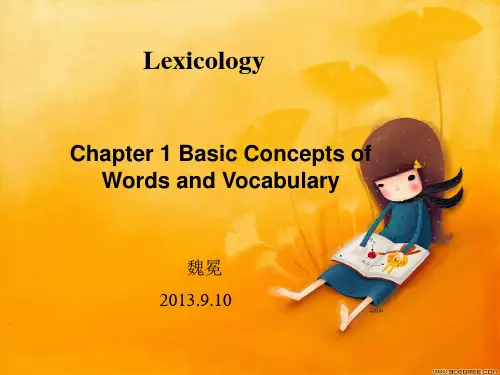

现代英语词汇学教程摘要:现代英语词汇学教程I.引言- 介绍现代英语词汇学教程的背景和意义- 阐述本教程的目的和适用对象II.英语词汇的来源和发展- 古代英语词汇的起源和发展- 中古英语词汇的演变和特点- 现代英语词汇的来源和构成III.英语词汇的分类- 名词、动词、形容词、副词等基本词类的特点和用法- 派生词、复合词、缩略词等特殊词类的构成和用法IV.英语词汇的用法和搭配- 词汇的惯用搭配和固定搭配- 词汇的语境和语域用法- 常见错误和误用词汇的纠正V.英语词汇的学习和运用- 学习英语词汇的方法和技巧- 英语词汇的应用和实践- 提高英语词汇运用能力的策略和技巧正文:现代英语词汇学教程现代英语词汇学教程是一门研究英语词汇的起源、发展、分类、用法和搭配等方面的学科,旨在帮助学习者更好地理解和运用英语词汇,提高英语水平。
本教程适用于英语学习者、教师和研究者等广大读者。
英语词汇的起源和发展可以追溯到古代英语时期。
在这个阶段,英语词汇主要以日耳曼语为基础,并受到拉丁语和希腊语等外来语的影响。
中古英语时期,英语词汇发生了较大的变化,尤其是在语法和拼写方面。
随着历史的推移,现代英语词汇逐渐形成,其来源和构成更加多样化。
英语词汇可以根据词性进行分类,包括名词、动词、形容词、副词等基本词类。
此外,还有派生词、复合词、缩略词等特殊词类。
这些词汇在英语中具有不同的特点和用法,学习者需要加以区分和掌握。
英语词汇的用法和搭配是英语学习中的重要环节。
学习者需要了解词汇的惯用搭配和固定搭配,掌握词汇在特定语境和语域中的用法。
此外,学习者还需要注意纠正常见的错误和误用词汇。
学习和运用英语词汇是提高英语水平的关键。
学习者可以通过词根词缀法、联想记忆法等方法学习英语词汇,积累词汇量。

词汇学论文英汉词汇文化内涵对比研究摘要词汇是语言的载体,是沟通和交流的基础,是文化的组成部分,同时也具有文化内涵。
文化,是语言发展的成果,是社会意识形态的集中反映,影响着社会生活,也影响着词汇的发展和变迁。
英汉词汇因所属国的文化历史国情不同而具有不同的文化内涵,集中体现在构词、语义和词义上等等。
本文通过分析对比英汉词汇文化内涵上的差异及其原因,旨在指导读者正确认识不同语言间的文化差异,更好地联系文化内涵深入地了解词汇的相关知识,从而在对语言的把握上提高一个层次。
关键词:词汇,对比,文化内涵,文化差异1. 引言人类社会在发展过程中产生了语言和文化,在语言的各个组成成分中,最能反映民族文化特征的是该民族语言的词汇,词汇背后反映的是该民族的文化认知方式。
英汉词汇因本民族的文化成就而有所差异,通过对比研究这两种语言的文化内涵,不仅可以凸显被对比语言的共性和特性,有重要的学术价值,也有利于有针对性地制定学习和教学策略,更可以为语言的综合研究提供相关资料,为词汇学的发展做出积极贡献。
2. 文化内涵2.1 文化内涵的定义英国人类学家爱德华·泰勒于1871年提出——文化是一个复合整体,包括知识、信仰、艺术、道德、法律、习俗以及作为一个社会成员的人所习得的其他一切能力和习惯。
这是以后文化被重复和扩展定义的基础。
文化具有传承性,动态性,民族性和多样性,文化作为一种历史现象,不同民族拥有不同文化,不同的文化之间既有共性又有个性。
语言作为文化的载体,语言的使用离不开作为社会河文化成员的人以及使用的语言环境。
2.2 文化与词汇的联系3.3 谚语谚语是心理,语言与文化的综合产物。
英汉中存在具有共同比喻的谚语,如:火上浇油——pour oil in the flame半斤八两——sin and half dozen破釜沉舟——burn one's boats以牙还牙——a tooth for a tooth但由于两个民族有各自独特的文化背景和各自独特的风俗习惯,思维方式,因此谚语联想,引申和比喻上有很大的不同。

英语词汇学教程英语词汇学是一门研究外语的语言学,它探讨的是英语的词汇,其有关规律和术语,以及学习英语词汇的最佳方法。
英语词汇学涉及语言识别,解释和使用,它是一门非常重要的研究,它在英语学习中有着不可缺少的作用。
英语词汇学让学习者了解英语中有多少单词,有多少不同的类型,以及它们怎样相互链接。
学习者还可以了解英语词汇的语音、语法、各种规律变化和词义构成,以及它们之间要具备哪些关系,比如继承、交叉、同位和异源关系等。
学习者可以理解英语词汇的套语、搭配以及其它文法上的规律和规范。
为了有效地学习英语词汇,学习者需要熟知英语单词的拼写、单词发音和词义。
另外,学习者还应该学习英语词汇的形成,熟悉常见的词缀、词根和合成。
学习者也需要熟悉常用词汇,以及英语词汇中固有的派生词,以便在日常交流中正确地使用词汇。
学习者可以通过各种方式学习英语词汇。
讲座和实验室课程是实验性学习的重要手段,可以更好地理解英语词汇学。
另外,使用视频教学软件已经成为提高语言能力的有效方式,学习者可以借此提高语法和口语的实践能力。
网络课程,如在线英语教学平台,也是学习英语词汇的重要手段,这样的课程提供了丰富的内容,旨在帮助学习者更好地学习英语词汇,并且给予学习者更多的机会,让他们能够在线完成英语课程。
英语词汇学也可以通过口语和书面的方式来学习。
首先,学习者需要有一定的英语听力和口语能力,能够理解别人的言谈,并且能够根据不同的上下文,正确地使用英语词汇。
其次,学习者也可以通过阅读原著书籍,以及阅读其它英语课本,来学习英语词汇,最后,学习者可以通过写作来检验自己的语言水平,从而进一步提高其英语词汇学的能力。
英语词汇学是外语学习中非常重要的一部分,它提供了一种有效的方法,让学习者更好地理解英语,更好地使用英语。
学习者可以通过听、说、读、写的方式,有效地学习英语词汇。
总之,通过学习英语词汇学,学习者可以发展良好的语言能力,更好地应用英语,从而有效地实现英语学习目标。
![当代英语词汇教学[论文]](https://uimg.taocdn.com/0ac40bcc5fbfc77da269b133.webp)
当代英语词汇教学浅论摘要:英语作为当今世界的通用语言,是我国在校学生必学的一门外语。
然而多年的英语教学现实却让我们十分尴尬,学习英语的人越来越多但学好的人却越来越少。
本文从英语语言知识学习体系中选取了词汇这一最基本和最重要的模块,探讨了英语词汇教学现状、词汇重要性以及词汇教学方法等几个问题,以期对广大英语学习者学好英语有所启发。
关键词:词汇;词汇重要性;教学现状;教学方法中图分类号:g642 文献标识码:a 文章编号:1002-7661(2013)09-005-01语言是人类最重要的交际工具。
英语是当今世界使用最为广泛的语言,学好英语无论是对在校学生还是其他社会人员都有重要的现实意义。
从整体上来说,语音、词汇和语法依然是英语学习的三大模块。
英语的特性和规律决定了词汇是整个学习体系中的基础和中心。
下文将从英语词汇的重要性、词汇教学的现状以及词汇的教学方法等三个方面谈谈英语学习中的词汇教学。
一、英语词汇的重要性语言是音义结合的词汇和语法体系,亦即语音、词汇和语法构成了一门语言,三者紧密相连相互依存。
语音是语言的物质外壳,是语言传递和表达的介质。
一种语言的语音体系是经过长期的历史发展形成的,在相当长的历史时期内会比较稳固。
英语中总共只有26个字母,每个字母有固定的发音,不同词汇中的字母组合也有特定的发音规则,而这些数量极其有限的读音规则是很容易就能够掌握的。
语言是社会交际工具,语音只有结合为词才能表达一定的意义。
所以语音的学习要以词汇为载体,在词汇中进行。
语法是语言的组织规律,是人类思维长期抽象化工作的成果。
由于语法有更大的概括性,语法规则比词汇单位的数量少得多。
学习一种语言,可以在较短的时间内掌握语法,但词汇量的扩充却需要大量的时间。
与此同时,语法的高度概括性使其十分稳固,变化发展极其缓慢,短期内掌握后无需进行不断的更新和扩充。
二、英语词汇教学的现状1、标准制订严重有误。
2000年版《九年义务教育全日制初级中学英语教学大纲》对词汇量的要求是800个,另外要求400-500个认读词汇,合计1200-1300词。
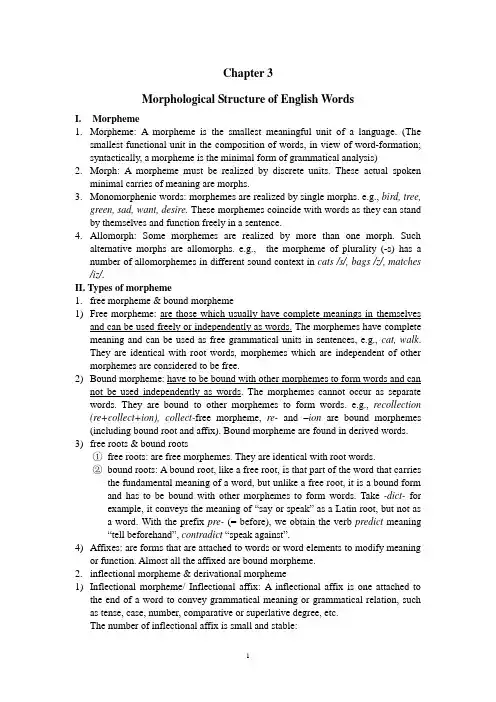
Chapter 3Morphological Structure of English WordsI.Morpheme1.Morpheme: A morpheme is the smallest meaningful unit of a language. (Thesmallest functional unit in the composition of words, in view of word-formation;syntactically, a morpheme is the minimal form of grammatical analysis)2.Morph: A morpheme must be realized by discrete units. These actual spokenminimal carries of meaning are morphs.3.Monomorphenic words: morphemes are realized by single morphs. e.g., bird, tree,green, sad, want, desire. These morphemes coincide with words as they can stand by themselves and function freely in a sentence.4.Allomorph: Some morphemes are realized by more than one morph. Suchalternative morphs are allomorphs. e.g., the morpheme of plurality (-s) has a number of allomorphemes in different sound context in cats /s/, bags /z/, matches /iz/.II. Types of morpheme1.free morpheme & bound morpheme1)Free morpheme: are those which usually have complete meanings in themselvesand can be used freely or independently as words. The morphemes have complete meaning and can be used as free grammatical units in sentences, e.g., cat, walk.They are identical with root words, morphemes which are independent of other morphemes are considered to be free.2)Bound morpheme: have to be bound with other morphemes to form words and cannot be used independently as words. The morphemes cannot occur as separate words. They are bound to other morphemes to form words. e.g., recollection (re+collect+ion), collect-free morpheme, re- and –ion are bound morphemes (including bound root and affix). Bound morpheme are found in derived words.3)free roots & bound roots①free roots: are free morphemes. They are identical with root words.②bound roots: A bound root, like a free root, is that part of the word that carriesthe fundamental meaning of a word, but unlike a free root, it is a bound form and has to be bound with other morphemes to form words. Take -dict-for example, it conveys the meaning of “say or speak” as a Latin root, but not asa word. With the prefix pre- (= before), we obtain the verb predict meaning“tell beforehand”, contradict “speak against”.4)Affixes: are forms that are attached to words or word elements to modify meaningor function. Almost all the affixed are bound morpheme.2.inflectional morpheme & derivational morpheme1)Inflectional morpheme/ Inflectional affix: A inflectional affix is one attached tothe end of a word to convey grammatical meaning or grammatical relation, such as tense, case, number, comparative or superlative degree, etc.The number of inflectional affix is small and stable:①the regular plural suffix –s (-es) which is added to nouns such as machines,desks.②simple present for the third person singular –s (-es)③the possessive case of nouns ’s④–er and –est to show comparative and superlative degree⑤the past tense marker –ed⑥–ing to form present participles or gerunds2)Derivational morpheme/ Derivational affix: A derivational affix in one that isadded to the beginning or the end of a word in order to create a new word.Derivational affix can be divided into prefix and suffix.①Prefixes: are the morphemes that occur at the beginning of a word. Theymodify the meaning of a stem, but usually do not change the parts of speech of the original word, e.g., pre+war, sub-sea.②Suffixes: occur at the end of stems. Though they can modify the meanings ofthe original words, their chief function is to change the parts of speech of words, e.g.: blood+y, child+ish.3)root: A root is the basic form of a word which cannot be further analyzed withouttotal loss of identity. It carries the main component of the meaning of a word. It can also be defined as that part of a word which remains after all the inflectional and derivational affixes have been removed, i.e. what remains of a word after the removal of all affixes.e.g., internationalists, removing inter-, -al, -ist, -s, leaves the root nation.4) stem: A stem can be defined as a form to which an affix can be added. A stem is that part of the word-form which remains when all inflectional affixes have been removed. In other words, any form to which an inflectional affix is attached is a stem.e.g., internationalists, nation is a root as well as a stem as the plural –s can be added to it; national is not a root as it can be further divided, but a stem because an inflectional affix –s can be added to it when used as a noun; similarly, international is not a root but a stem for the same reason.5) base: A base is used in this book as an all-purpose term, referring to a form to which affixes of any kind (both derivational and inflectional) can be added. (P51)。
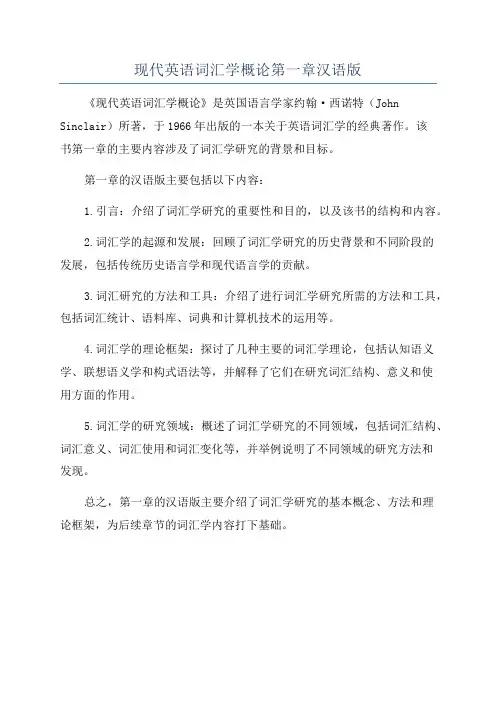
现代英语词汇学概论第一章汉语版
《现代英语词汇学概论》是英国语言学家约翰·西诺特(John Sinclair)所著,于1966年出版的一本关于英语词汇学的经典著作。
该
书第一章的主要内容涉及了词汇学研究的背景和目标。
第一章的汉语版主要包括以下内容:
1.引言:介绍了词汇学研究的重要性和目的,以及该书的结构和内容。
2.词汇学的起源和发展:回顾了词汇学研究的历史背景和不同阶段的
发展,包括传统历史语言学和现代语言学的贡献。
3.词汇研究的方法和工具:介绍了进行词汇学研究所需的方法和工具,包括词汇统计、语料库、词典和计算机技术的运用等。
4.词汇学的理论框架:探讨了几种主要的词汇学理论,包括认知语义学、联想语义学和构式语法等,并解释了它们在研究词汇结构、意义和使
用方面的作用。
5.词汇学的研究领域:概述了词汇学研究的不同领域,包括词汇结构、词汇意义、词汇使用和词汇变化等,并举例说明了不同领域的研究方法和
发现。
总之,第一章的汉语版主要介绍了词汇学研究的基本概念、方法和理
论框架,为后续章节的词汇学内容打下基础。
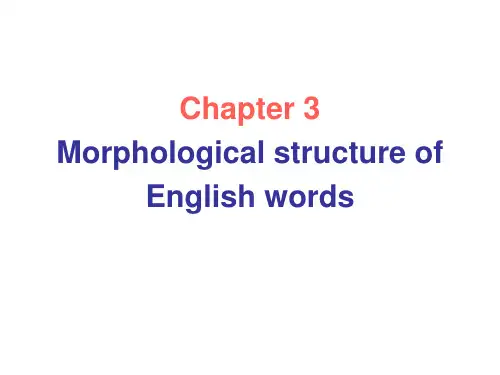

Chapter 2The Development of the English VocabularyI. The Indo-European Language Family1) Armenian2) Albanian Prussian普鲁士语Lithuanian立陶宛语Polish波兰语3) Balto-Slavic Czech捷克Bulgarian保加利亚语Slovenian斯洛文尼亚语Russian俄罗斯语an Eastern set Persian波斯语Bengali 孟加拉语4) Indo-Iranian Hindi 北印度语Romany吉普赛语Scottish苏格兰语Irish爱尔兰语1) Celtic Welsh威尔士Breton布列塔尼语Pictish皮克特语Portuguese葡萄牙语Spanish西班牙语2)Italic French法语Italian意大利语Rumanian罗马尼亚语The Indo-European 3) Hellenic: Greek is the modern languagederived from Hellenic Language Family an Western Set English英语German德语4) Germanic Dutch荷兰语Flemish弗来芒语NorwegianIcelandicScandinavian languages DanishSwedish5)Hittite6) TocharianII. A Brief History of English WordsEnglish has a history of only 1,500 years, developing from a local language spoken by a small number of people on a small island about the middle of the fifth century. But now English is one of the most important languages in the world, spoken by more than 370 million people as a first language in the United Kingdom, the USA, Canada, Australia, New Zealand, the West Indies and South Africa. And another 300 million people use English as a second language or official language, or as the medium of instruction in school and universities in those countries, English has a important position, it is estimated that the number of speakers with varying degrees of proficiency range between 800 million and 1 billion throughout the world.The English words that we use everyday are derived from a wide range of sources, mostly within the Indo-European family of language. The English vocabulary can generally divided into native words, borrowed words from other languages and hybrid words which we will discuss in the following.CelticNative ElementsThe Angles-Saxons-Jutes PeriodA History ofEnglish WordsLatin Influences on Old EnglishThe Scandinavian InfluenceMiddle EnglishBorrowed Elements The Norman Conquest and FrenchLoanwordsThe Early Modern English PeriodThe Re-establishment of EnglishModern EnglishHybrid Words1. Native Elements(1)Celtic (Pre-English Period---- 450AD)The first people in England are the Celts. They were the native inhabitants of the Britain. The Celtic languages were once spoken across Europe, they were driven to the north-west fringe of Europe. At the time of Roman invasion, the indigenous languages of Britain were Celtic. Celtic was probably the first indo-European tongueto be spoken in England.In the summer of 55 B.C. the Romans conqueror, Julius Caesar made Latin an official language of culture and government. The Celts in England had enjoyed the benefit of Roman government (55BC---410AD), worshipped in Christian churches, and spoke a certain extent, at least, the Latin language by social elite. The Romans never penetrated far into the mountains of Wales and Scotland in the course of Romanization of the Island, so the Celtic survived, but the Celts had not their own written language. Now we could see some of the place names are from the Celtic, e.g. Thames River, London, Ben Nevis etc.And we could say that Latin spoken rather extensively for centuries before the coming of English.(2)The Angles-Saxons-Jutes Period (450AD-1100AD)As to its origin, the English language is as humble and obscure. It was brought by the German tribes-Jutes, Angles, and Saxons, who conquered the island in the 5th century (449AD), and became the founders of the English nation. The result was the known as Anglo-Saxon Period or Old English Period. Now in word “English”, the “Engl-”goes back to the Angles, the “-ish”means “belonging to”, so the language belonged to the “Angles-” the “Angle-ish” language.The English language of today is the language that resulted from the history of the dialects spoken by the three Germanic tribes, and the subsequent mixture of the three people. The vocabulary of Old English is almost purely Germanic. English is classified as a Germanic language to which German, Dutch, Flemish, Danish, Swedish, and Norwegian also belong. It shares with these languages similar grammatical structure and many common words. About 20-30 percent of English vocabulary is the Angles-Saxons words. So the Angles-Saxons words are considered to be the native English words and the core of English vocabulary.2. Borrowed Elements(1) Latin Influences on Old English (579AD-1150AD)Latin influenced English through Celtic transmission and Chiristianizing of Britain. With the introduction of Christianity into Britain, the Latin influence was not only extensive, but thorough and marks the real beginning of the English habit of freely incorporating foreign elements into its vocabulary.And more than half of present words in common use are derived from Latin used in military and official class, cities and towns. By means of prefixes and suffixes, a single root is made to yield a variety of derivative and the range of these is greatly extended by the ease with which compound are formed. So the noun, the adjective, the definite article, the personal pronoun, the verb, and preposition express fundamental concepts, especially the ideas of scientific and learned character. It was more resourceful in utilizing its native material than Modern English, which has come to rely to a large extent on its facility in borrowing and assimilating elements from other language, e.g.church--- abbot/ bishop/ monk/ pope/ priest/ temple/ ruleclothing and household----cap/ chest/ mat/ purple/ sack/ silk/ sockfood----pear/ lobster/ cookanimals----elephant/ camel/ tigereducation and learning----school/ grammar/ meter/ master/ noon/ anthem/ angel/ verse/ gloss/ circle/ talent(2)The Scandinavian Influence (c.9-c.11)Scandinavia elements that entered into English language are such as would make their way into it through the give-and-take of everyday life. The earliest loans referred specifically to objects and concepts related to Danish culture, including for boats, for currency, for warriors and place-names. The number of Scandinavian words, according to “English Dialect Dictionary”, there are 1150 simple words were Danish element. Many words with “sc/sh-, sk-” are Scandinavian origin, e.g.Noun---- bank/ birth/ bull/ dirt/ down/ egg/ fellow/ gap/ guess/ kid/ leg/ skirt/ sister/ skin/ trust/ want/ windowAdjective----awkward/flat/ low/ odd/ rugged/ tight/ weakVerb---- call/ die/ get/ give/ lift/ raise/ take(3)Middle English----Period of Great Change (1100AD-1500AD)The change of this period affected English in both its grammar and vocabulary. Those in the vocabulary involved the loss of a large part of the Old English word-stock and the addition of thousands of words from French and Latin.(4)The Norman Conquest and French Loanwords (1066AD-1500AD)In 1066AD, Britain was conquered by Normans. Through the influence of Norman French, the Old English period gradually ended. The Norman conquerors spoke French, so French words were borrowed directly and observably, affected English vocabulary and spelling. English and French elements are mixed. French words were borrowed from a wide range of different areas: government, law, hunting, sport, social relationship, morals, fashion, cuisine, etc.Despite the many French loanwords, English remains English, the very heart of the vocabulary remained English. Middle English is characterized both by its greater French vocabulary and by the loss of inflections. However by the end of the Middle English period, only two of these inflections remained in use, “-es” for plural nouns and the past tense marker “-ed”.(5)The Early Modern English Period (1500AD- 1700AD)This is a period of loss inflections. We know that the influence of Latin and Greek in this period was great by social elite, but not used by the majority of the population. The great humanistic movement of Renaissance took place at the period and increased activity in almost every field; the printing press; the reading habit; the rapid spread of popular education; the increased commerce, transportation and rapid means of communication----books, magazines and newspapers; the growth of specialized knowledge and the emergence of various forms of self-consciousness about language; the reform of church etc. The social, commercial, technological, and intellectual force released in the Renaissance, had profound effects on the English. The result was a healthy desire for improvement of new words in various technical fields, where English was notable weak. The great number of new and strange words was borrowed from Latin, Greek, French, Italian, Spanish etc. e.g.①from Latin and Greek: words relating technical, biological, legal and medical names and terminology, e.g.education----act, animal, cherries, church, cup, describe, discuss, dish, disability, equal, exist, expect, graduate, piazza, street, wall, wine, violin…literature----anthology, catastrophe, comedy, drama, emphasis, magic, myth, poet, rhythm, tactics, tragedy…philology and maths----basis, geometry, category, ethics, thesis, theory, hypotenuse…biology, physics and chemist----bulb, dynamo,organism, pneumatics, thermometer…medicine and science----cancer, cleaner, diagnosis, neuralgia, phonograph, rheumatism, telephone, television…linguistics----antonym, dialect, euphemism, etymology, homonym, idiom, lexicology, metaphor, metonymy, polysemy…affixes---- auto-, bio-, geo-, tele-, photo-; -able, -ible, -al, -id, -ism, -ist, -ive, -ize, -oid, -logy, -ology, -ous, -tics…②from French: French language altered the English vocabulary much in the governmental, administrative, law, army, navy, art, learning, medicine, fashion, meals and social life words.government and administrative words----alliance, authority, court, crown, empire, governor, justice, judge, jury, liberty, majesty, minister, noble, office, peasant, prince, public, royal, slave, servant, state, tax, treaty…religion and ecclesiastical words----charity, clergy, confession, creator, faith, mercy, miracle, mystery, passion, prayer, sacrifice, sermon, solemn, virtue…law----accuse, arrest, complaint, decree, evidence, heir, proof, prison, property, sentence, summons…army and military----arms, battle, captain, conquest, defense, enemy, guard, mail, peace, soldier, spy, victory…literature----copy, grammar, logic, preface, prologue, prose, title, volume…clothes---button, coat, collar, dress, embroidery, robe…food----appetite, biscuit, beef, feast, fruit, grape, lemon, olives, orange, peach, pork, plate, roast, mutton, sugar, supper, toast, taste…art----figure, painting, palace, music, sculpture, tone…science---- physician, patient, poison, pulse, remedy, surgeon…fashion and social life----blanket, boots, chair, curtain, diamond, jewel, pearl, screen, train…(6)The Re-establishment of EnglishConditions were changed after 1200. It was succeeded by a conflict of interests and a growing feeling of antagonism that culminated in a long period of open hostility with France. “The Hundred Years’ War ”(1337-1453) between England and France was one of the causes to use English as the language of the country.English began to be used in the schools, in the law courts and writing, and become the standard English both speech and writing toward the end of the 14th century. Geoffrey Chaucer (1340-1400) vividly reflected the changes in his English words. And in the later part of the 15th century London Standard had been accepted as the Standard English and in the 16th century, the use of London English had become amatter of precept as well as practice. By the end of 17th century, Britain grew commercially and acquired overseas colonies. English was taken to the American and India. With the rise of printing, English acquired a stable typographic identity. Shakespeare is the greatest writer in this period. It is noted that Shakespeare’s vocabulary of over 30,000 words. During 18th century, many foreign loans continued to enter the English vocabulary.(7)Modern English--- the Last Two Centuries (the 19th ---- 20th centuries)Great political and social events influences affected the English language. The expansion of English vocabulary is amazingly rapid. The reasons are:●the success of the British on the sea in the course of the Napoleonic Wars●the war against Russia in Crimea●the contest with princes in India●great reform measures●the establishment of the first cheap paper●the improved means of travel and communication brought about by therailroad, the steamboat, the telegraph●the growth of England’s larger colonies●the rapid development of the United States●the rapid development of modern science and technology●political, economic and social changesMost of the new words have come into English by borrowings which have extended the vocabulary of the language and formed the cosmopolitan character of the English vocabulary. Thousands of new words are added, existing words acquire new meanings, and old words die out, e.g.medicine----AIDS, aspirin, bacteriology, carbohydrates, cholesterol, metabolism, morphine…science----atomic energy, black hole, DNA(deoxyribonucleic acid), relativity…automobile, film, broadcasting, computer----cartoon, cinema, loudspeaker, highway, microphone, PC, three-D, VCR…。
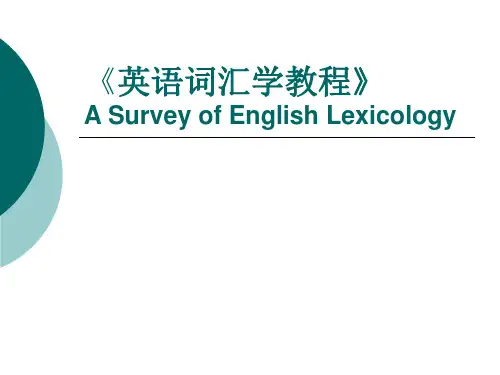
Lexical Meaning and ContextAbstract: With the With the development of technology, more and more new words are used to express a new concept, but not every appearance of new concepts are accompanied by the emergence of a new word. Therefore, many ordinary words are also used to express a particular concept. Because of the different location and the different meaning, words have the contextual meaning. As an English-language learners, nor only should we understand the basic meaning of the words, but also we should learn the contextual meaning.I divided this passage into four parts, which is definition of context, contextual restrictions, the factors of the context and the influence of context. We can understand the method of analyzing the words in context and the impact of various contextual meaning of words. Then, we should try our best to understand the meaning of English words in the sentence by the provided clue. It can help us to avoid embarrassment of misunderstanding.Key words: Definition; Factors, Contextual restrictions; Influence1.The definition of contextContext is of great importance for the understanding of word meaning, especially for the understanding of the meanings of polysemic words. The important role in the study of context in semantics is increasing brought to the attention of the people. In language communication, context is always changing, which leads to changes in the dynamic semantics. Without the context, the words’ meaning will be pale, indefinite and puzzling. What’s more, the communication will be failed. Therefore, we should know denotative meanings of a word as much as possible and generally there will be no risk of misunderstanding the meaning, when it occurs in a particular context.2.The factors of contextModern linguists have not only placed great emphasis on context but have considerably broadened its scope, and have also probed deeply into its influence on word meanings. The range of the term context has been widened in several directions. Its also no longer restricted to what immediately precedes and follows, but many cover the whole passage and sometimes the whole book in which a word occurs, and in some cases even the entire social or cultural setting.The factors of context can be divided into three parts. The first factor is natural environment. There are different geographical location between Chinese and English. They have different lifestyles and different characteristics of the word meaning. England is an island country. Its maritime industry was once the top of the world. Thus, many words were produced from navigation. Han Chinese live and multiply in the Asian continent. People can not live without land, land. Land is vital for people, soa lot of Chinese words or idioms are related to land. The second one is culture. Different country has different culture and different customs. Different language implies different national culture and the words also carry a lot of national cultural accumulation. This accumulation plays an important role of ways of thinking and language behavior. When we use “牛饮” to describe the big drinkers, English would say: Drink like a fish. Therefore, in order to understand the meaning of the words in a context, we should learn the culture or background of the words.3.The contextual restrictions on word meaningLondon School Firth founded context in the 1940s. Since the context was founded, linguists expressed their different opinions frequently. Different researchers selected different perspective to use different elements to make different definition of context.Translators analyze and understand the passage by the source of language information to convert and express the understanding meaning of the passage. In this process, whether can the translators accurately understand and express the original information? Not only should they rely on their language skills, personal experiences and the translation skills, but they should focus on the most important thing that is the source language text analysis and understanding accuracy. The accurate analysis of discourse and understanding is inseparable from context, because the usage of every language has its own the context.A.Two types of contextsNowadays, the context was divided into two types: Linguistic Context and Extra- linguistic context.[1] The former refers to the process of communication in the specific environment. It includes words, sentences, paragraphs and passages and so on. The latter one refers to the situation which is limited by the language communication, society and the communicators themselves, such as the specific occasion, time, topic and the character of communicators.In English, polysemy can be seen frequently, including basic meaning, expanding meaning, and metaphorical meaning and so on. However, when a word enters the semantics of the system, its meaning would be single and certain because of the restriction of semantic subjacency. In other words, in the context, the word only has a single meaning which can accurately express the meaning of the sentence or the passage. Therefore, in order to understand the meaning of a word, we must set it into a concrete context. English words meanings are flexible and they always be restricted by the context. Different context make the word has different meanings.American linguist Dwright Bolinger said: In order to understand the meaning of a word, we should rely on the entire semantic range of the word and the function of this word and other word in the same occasion! [2]For example, the preposition “on”has 10 meanings totally in the Anglo Dictionary, but in the specific context, it has only a meaning in a sentence.①a book on the table( 在......上); ②a town on the river( 在......旁); ③smile on somebody( 向着......); ④live on one’s salary (依靠.......); ⑤on questions of common concern(关于......); ⑥be on the committee(是......的成员); ⑦be on leave( 处于......情况) ; ⑧talk on the telephone(以......方式); ⑨on Sunday( 在......时候) ; ⑩Thislunch is on me( 由......支付) 。
英语词缀构词与英语单词记忆初探康超096070157摘要:针对词汇记忆与遗忘这对矛盾,笔者试图利用词缀构词法分析词汇,研究英语词汇的构造,找出单词内在的结构和联系规律,并归纳总结其构成规律和特点,帮助正确理解、掌握词汇,并能灵活运用词缀构词法解构所学单词,进一步巩固和拓展词汇量。
关键词:英语词汇记忆词缀构词引言:词汇是构筑语言的基本材料,词汇在语言交际中起着非常重要的作用。
英国语言学家Wilkins 就曾经说过:“Without grammar, a little can be conveyed, without vocabulary, nothing can be conveyed.”对于英语学习者来说,词汇量的大小直接影响到其掌握和运用该语言的熟练程度。
只有具备了一定的词汇量,才能更好地发展听、说、读、写、译等其他基本技能。
此外,词汇在语言发展中也起着非常重要的作用。
据统计,英语作为世界上词汇最丰富的语言,其词汇已经远远超过了200 万个。
而语言是随着社会的发展而发展的,英语词汇正以每年至少850 个新词的速度增加。
根据艾宾浩斯遗忘曲线原理,记忆与遗忘交叉于人的记忆过程之中。
所以,我们必须在学习和记忆英语词汇的过程中,寻求科学的记忆方法来解决记忆与遗忘这对矛盾,有效便捷地记忆词汇,深化词汇学习。
正文:单词、词素的定义单词是语言中最小的自由形式。
而词素是语言中最小的意义单位或元素。
词素可以是一个单词,也可以是一个词缀。
英语词缀是英语形态构词中的一种黏附语素(bound morpheme)。
它既不能单独存在, 也不能独立使用。
它常常附在自由语素(free morpheme)的前面或后面或嵌在其他语素中间, 只表示附加意义和语法意义, 而不表示词汇意义。
一般来说,按功能可分为屈折词缀( inflectional affix) 和派生词缀( derivational affix) ; 按其在词素组合中所处的位置分为前缀( pre-fix)和后缀( suffix) ( 林崇德2004: 482-490) 。
英语词汇学课程论文写作要求及评分标准一.课程论文格式要求1. 论文版式要求1 )标题:主标题:3#字黑体,粗体,居中;一级标题4号宋体加粗(1*****)、二级标题小四号宋体加粗(1.1 ***** )、三级标题5号宋体加粗(1.1.1 ***** ),正文中文用5 号宋体(不能加粗),英文用5号Times New Roman (不加粗);2 )中文摘要:(5号黑体加粗),英文abstract : (5号黑体加粗),内容:中文宋体5 号(200 字以内),英文5 号Times New Roman;3)关键词:(5号字黑体),Key words: (5号字黑体),内容:(3~5个)中文宋体5号(200 字以内),英文 5 号Times New Roman;4)正文:宋体5号字;固定1.25倍行距;按标准word格式页面上下、左右行距排版,即左右 3.18cm,上下2.54cm ;5)页眉横线上加标题;页脚:页码第x页共x页---居中。
6)参考文献(宋体小5号字黑体),5篇以上参考文献,要求 1 —2篇外文文献。
示例:[1] Gad Saad, Mark Cleveland, Louis Ho. Individualism-Collectivism and the Quantity VersusQuality Dime nsions of In dividual and Group Creative Performa nee [J]. Journal of Bus in ess Research, 2014: 39-42.[2] 陈熙.跨文化视角下中美家庭教育比较研究一以《虎妈赞歌》为例[D].成都:成都理工大学,2014.[3] 晨曦.美国父母家教的科学方法:世界一流的素质教育[M].合肥:安徽人民出版社,2002: 12-13.[4] 杨文澜.“从《早熟》和《朱诺》看中美家庭教育差异”[J].《文艺理论》,2011 (8):74-76.2. 课程论文字数应在3000字以上;严禁抄袭或剽窃,否则按零分处理;3. 论文提交打印版(A4纸);依封面、正文的顺序,左边装订;4. 提交时间14周周五下午第七节课之前学习委员统一收齐交至核工楼102,过期无成绩;二.评分标准1. 题目:题目应结合课程教学要求,应能概括整个论文最重要的内容,简明、准确、引人注目一般不宜超过20字,必要时可加附题。
《英语词汇学教程》论文中文版
英语词汇学论文(中文版)
单词记忆法细谈
一, 读音规则记忆法
它就是按照元音字母、元音字母组合、辅音字母及辅音字母
组合在开音节和闭音节的读音规律记忆。例如:ea,ee,er,
ir,ur,or分别能发[i:][:][:]等。还有些固定的字
母组合,例如: ing发[i],ly发[li],ty发[ti]和各
种前缀、后缀,例如:a-,re-,un-,dis-,im-;-ed,-ing,-ly,
-er,-or,-ful,-y等都有其比较固定的发音。掌握了这些规则,
记单词时就不必一个字母一个字母地记忆了。? 二.字母变
化记忆法
英语单词中以某个单词为基础,加、减、换、调一个字母
就成了另一个新单词。具体方法如下:? 1.前面加字母。
例如:is/his,ear/near/hear,read/bread
2.后面加字母。例如:hear/heart,you/your,pla
ne/planet
3.中间加字母。例如:though/through,tree/three,
for/four
4.减字母。例如:she/he,close/lose,star/tstar
5.换字母。例如:book/look/cook,cake/lake
/wake/make/take
《英语词汇学教程》论文中文版
6.调字母(即改变字母顺序)。例如:blow/bowl,sing/
sign,from/form?三.联想记忆法
在日常生活中可以根据所处的环境,所见到、所摸到的事
物,联想相关的英语单词。例如:打球时联想到:ball,(p
lay)basketball,(play)football,(play)volleyball,p
layground等等;吃饭时联想到:dining-room,(have)br
eakfast,(have)lunch,(have)supper等等;睡觉时联想
到:bed,bedroom,gotobed,sleep,gotosleep,fal
lasleep等等。如果长期坚持下支,效果就会很好。?四.归类
记忆法? 众所周知,单词本身、单词与单词之间都存在
着或多或少的联系,英语词汇中有许多单词有着其近义词、反
义词、一词多义、一词多音、同音词或形音形似词等内在或
外在的联系。因此,记忆单词的主要方法是把单词之间存在的
这种联系挖掘归纳出来,通过对比、对照的方式把学过的单
词从各个方面进行归类
1.按词的构造归类
按词跟、前缀、后缀、合成词归类,找出词与词最本质的联
系。这种联系不仅使新词记得快、记得牢、记得久,而且也
同时复习了大量的旧词。合成词,如:
schoolbag, school-boy, classroom, footba
ll, blackboard, etc.
《英语词汇学教程》论文中文版
前缀后缀词,如:unhappy, unhealthy, unfriendly, u
nlucky, worker, writer, visitor, useless, carele
ss, etc
2.按同义词或反义词归类
随着学生词汇量的增加,可逐渐进行此项归类。如:tak
e off(脱下)与put on (穿上),safe(安全)与dangerous(危险);
get to (到达)与arrive at\in(到达)与reach(到达)。
3.按题材归类
ﻫ 在日常交谈中有不同的话题。按题材归类就是把同一
个话题经常出现的词汇归集在一起,如Our Family, Ou
r School, Food等。话题的范围可大可小,可以把上述的题目
再划小些。从Our School 中还可以划分出Our Classr
oom, An English Lesson 等
4.按语音或拼读规则归类
如果是开音节和闭音节,可以按其读音规则读出并记忆单
词,当然有一些特殊的不规则的单词,那就只好进行特殊记忆。
比如根据词形和一些有关的幽默、搞笑故事联系起来记忆单
词。
同形异义词、同异音词、异形同音词、形音相似词等加
以分类。同形异义词类常用的词有:catch, carry, come, g
《英语词汇学教程》论文中文版
o, get, keep, play等。例如:(1)play football(踢足球);
(2)play basketball(打篮球);play the piano(弹钢琴);
play computer games(玩电脑游戏);play in the park(在公
园玩耍)。同形异音词大体可分为三类:(1)一词两音,词义不
变;(2)读音随词性的变化而改变,其词义基本不变;(3)读音随
词性、词义的变化而变化
五.构词记忆法? 掌握一些构词法知识,可以大大地增加
自身的词汇量。英语构词法主要有以下三种情况:? 1.派
生法。这种方法就是在一个词根的基础上加上一个前缀或后
缀,从而构成另一个新词,并且与该词根的含义有着密切的
联系,此类词便称为派生词。如常用的前缀in-,im-,un-,dis-
等表示否定含义;后缀-er,-or,-ist等表示人;以及后缀-y,-ly,
-ful等表示形容词性等。如:like-unlike,teach-teacher,f
riend-friendly等。
2.合成法。这种方法就是把两个或几个各自独立的单词
并到一起组成一个新的单词,由此法构成的单词便称为合成
词或复合词。如:black(黑色的)+board(木板)blackboard(黑
板),class(班)+room(房间)classroom(教室),foo
t(脚)+ball(球)football(足球)等。? 3.转化法。这
种方法就是在不改变拼写形式的基础上,由一种词性转化为
另一种词性,主要有名词转化为动词、动词转化为名词、形容
词转化为动词或名词等。如:water(n.水)water(v.浇水),
《英语词汇学教程》论文中文版
lift(v.举起)lift(n.电梯),last(adj.过去的)last(v.持续)
等。?六.循环记忆法:它是指对识记的单词反复记忆的方法。
根据遗忘规律,人的遗忘从识记后便开始,先快后慢。因此,复
习的时间间隔就应是先短后长。例如,今天学到的单词,在当
天背熟之后,第二天、第四天、第七天、第十四天、第二十八
天都应复习一次,这样才能形成长时间的记忆。总之,单词记忆
的方法多种多样,只有采用科学的、行之有效的记忆方法,
认真地、及时地、周期性地复习,才能大大提高英语单词的
记忆效果。